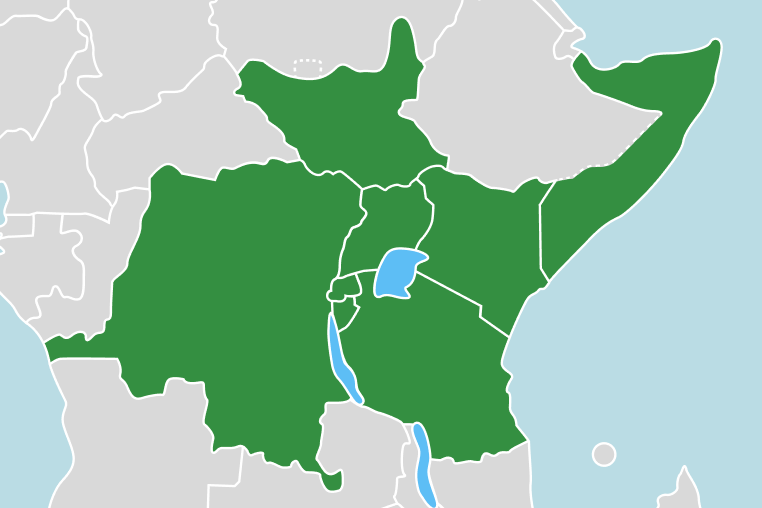The East African Community and the AfCFTA

The African Continental Free Trade Area (AfCFTA), under which trading began in January 2021, seeks to create a major economic and technological transformation across Africa’s 54 countries (all AfCFTA signatories) at national and regional levels through making use of and adding value to Africa’s diverse resources, within the context of deeper regional integration. It seeks to address Africa’s development challenges by progressively moving from a factor-driven to an investment- and efficiency-driven approach, and ultimately to a high growth level driven by knowledge, innovation and business sophistication.
Currently, trade among African countries accounts for 14.3% (average 2019 to 2021) of their total trade. This figure is considerably lower than that of trade within other regions, including Europe and North America, which have intra-regional trade rates at over 60%. The United Nations Economic Commission for Africa estimates that the AfCFTA could increase trade between African countries by as much as USD 55 billion – an increase of more than 75% – by 2045 from current levels. The estimates also show large potential gains from the AfCFTA, including a projected increase in intra-African exports of Eastern Africa by nearly USD 1 billion and job creation for 500 000 to 1.9 million people. Clearly, that makes the AfCFTA attractive to investment, both from within and outside the continent.
The East African Community’s (EAC’s) trade with the rest of Africa is low. The AfCFTA is expected to directly impact the EAC’s trade relations with Africa, especially countries that are not members of the EAC, the Southern African Development Community (SADC) or the Common Market for Eastern and Southern Africa (COMESA). Together, African economies have a collective GDP of USD 2.5 trillion, making the continent the eighth largest economy in the world. This calls for business people to take advantage of the AfCFTA and make the necessary investments to sustain economic growth and create employment.
How the EAC is preparing the ground for the AfCFTA
The EAC Secretariat has embarked on capacity building and awareness creation for all stakeholders on the provisions and opportunities of doing business under the AfCFTA.
However, the business community in the EAC requires more than the historical background, legal text and potential impact of the AfCFTA. It needs to know what it takes to trade under the AfCFTA; the details of offers made by respective partner states in the EAC region; the actual demand in the markets offered through the agreement; and logistical requirements. The AfCFTA’s trade opportunities have to be translated into what makes business sense.
There has been considerable progress in the EAC region regarding the AfCFTA, with input from the GIZ. So far, a joint offer for trade in goods and an initial offer for trade in services have been developed and submitted to the African Union Commission. And capacity building has been facilitated among customs officials and the private sector to foster a clear understanding of the offers made, market demand and other requirements.
GIZ assistance to the EAC on the AfCFTA focuses on:
Trade in goods
To support trading under the AfCFTA, the GIZ is assisting the EAC to produce a simplified, user-friendly and well-illustrated guide on AfCFTA trade and trade-related rules. Support is also being given to EAC partner states in preparatory work for the implementation of the agreement and finalisation of outstanding negotiations on trade in goods
Trade in services
The programme supports EAC partner states in preparatory work for the implementation of the agreement and finalisation of outstanding negotiations on trade in services (TiS), as well as additional commitments to TiS, including conducting an EAC regional study on TiS for the AfCFTA
Phase I and Phase II issues
The programme supports EAC partner states in their preparatory work for negotiations on Phase II and III issues – especially in the areas of investment, competition and intellectual property rights (IPR) – through a range of mechanisms such as capacity building, undertaking scoping studies, gap analysis studies and development of an EAC IPR strategy
Stakeholder engagement
The GIZ is partnering with the EAC in its efforts to sensitise the business community and general public in advance to ensure that key stakeholders, including small and medium-sized enterprises, effectively participate in and benefit from the AfCFTA to achieve the objective of shared growth across the region and continent. Further, GIZ awareness-raising efforts around the AfCFTA are also targeting civil society and the private sector and engaging with female cross-border traders and traders’ associations
The GIZ also contributes to strengthening the technical and administrative capacities of the EAC Secretariat for it to more effectively play a role in fostering coordinated negotiations on and realisation of the AfCFTA at regional and national levels.
Facts and figures
The AfCFTA will help Ghana boost its intra-African trade, which currently accounts for a relatively small proportion of the country’s imports and exports.
Total EAC trade increased 13.4% to USD 74.03 million in 2022, from USD 65.27 million in 2021, and is partly attributed to improved EAC total exports to the Economic Community of West African States (ECOWAS) region, which increased by 48.5% to USD 136.1 million in 2022 from USD 91.6 million in 2021
Total intra-EAC trade grew by 11.2% to USD 10.9 million in 2022 from USD 9.81 million in 2021
EAC total exports to the rest of Africa increased by 10.4% to USD 8.9 million in 2022 from USD 8.06 million in 2021
Our partners in the EAC
Political partner: EAC Secretariat
